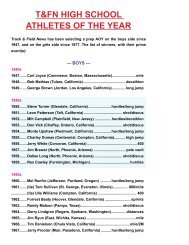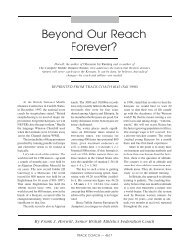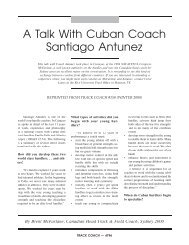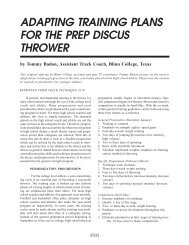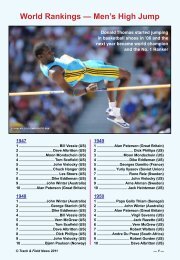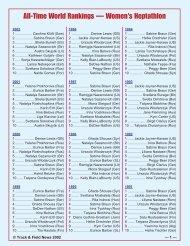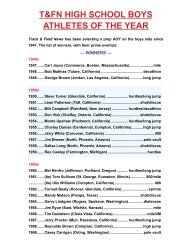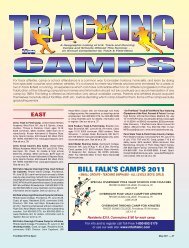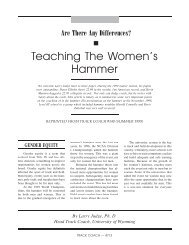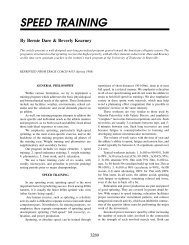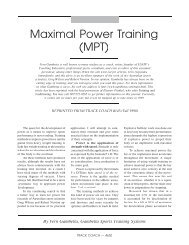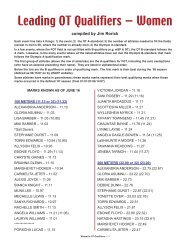Identifying And Developing Elite Hurdlers In The United States
Identifying And Developing Elite Hurdlers In The United States
Identifying And Developing Elite Hurdlers In The United States
You also want an ePaper? Increase the reach of your titles
YUMPU automatically turns print PDFs into web optimized ePapers that Google loves.
2. Isokinetic testing can be useful in<br />
identifying imbalances between<br />
legs, e.g., Cybex testing to determine<br />
harmstring-quadriceps ratios,<br />
hamstring-hamstring, quadricepquadricep,<br />
etc.;<br />
3. Aerobic base. 2400m aerobic run<br />
will determine aerobic/cardiovascular<br />
base and general overall fitness.<br />
Mostly used when returning from<br />
summer break to determine if they<br />
followed training regimen;<br />
4. Speed. 30m fly/30m standing—determines<br />
both absolute or top speed<br />
and ability to accelerate;<br />
5. Power. Overhead back/between legs<br />
forward/vertical jump/standing long<br />
jump—all indicate leg power or total<br />
body power;<br />
6. Power/co-ordination/speed. Standing<br />
triple jump/3-5 bound—both<br />
indicate leg power, speed and coordination;<br />
7. Max and dynamic strength. 1RM<br />
bench press/back squat/power<br />
clean.<br />
It has been found that leg power is<br />
a primary determinant of track and field<br />
performance (Henson, 1993). Thus, leg<br />
power tests are useful; however, you<br />
must choose testing parameters that you<br />
feel are pertinent to your program. <strong>The</strong><br />
coach must keep accurate records, be<br />
consistent with regards to when tests<br />
are performed, as well as how tests are<br />
administered or testing will be useless<br />
to you. You can then compare over<br />
time who are the best athletes, predict<br />
performance, or assess your training<br />
program.<br />
Test Analysis<br />
It is important for the coach to be<br />
able to interpret the results. Coaches<br />
can utilize test results in different ways.<br />
<strong>The</strong>re are many normative, elite, and<br />
“sedentary” tables that a coach can<br />
use for comparison. One way is to assign<br />
scores to each performance and<br />
add them together to get a total score,<br />
using tables such as <strong>The</strong> Hungarian<br />
Tables (i.e., quadrangular test). Here<br />
you are able to identify talent and predict<br />
performances. With athletes who<br />
are already involved in your program,<br />
you can compare the results from one<br />
season to the next or from one month<br />
to the next to determine the effects of<br />
your training program. If athletes are<br />
recording a steady progression over<br />
time, development is evident and the<br />
program is effective. If the athlete is not<br />
progressing, then one must identify the<br />
problem area and change the programming.<br />
Problems of the Youth Hurdler (Ages<br />
14-17)<br />
<strong>The</strong> following is a list of common<br />
problems in hurdle development that I<br />
experience with the high school age<br />
athlete:<br />
1. Under-development biomotor abilities/lack<br />
of overall fitness. Fitness is<br />
the ability of the athlete to function<br />
efficiently and effectively in the<br />
specific demands of training and<br />
performance (Sands, 1995). This<br />
includes lack of cardiovascular base,<br />
work capacity, flexibility (especially<br />
in boys), postural/general strength,<br />
local muscular endurance, and<br />
coordination. <strong>The</strong>re appears to be<br />
little exposure to strength training<br />
in these years, as well as rehearsed<br />
coordinated movements. Many<br />
speculate that this is due to the lack<br />
of physical education requirements<br />
in the grade school systems.<br />
2. Training age is very young: Training<br />
age is the number of years preparing<br />
specifically for the hurdles.<br />
<strong>The</strong> exposure to the hurdle events<br />
is perhaps occurring too late. This<br />
could be due to the absence of hurdle<br />
coaching or perhaps because they<br />
were not identified and encouraged<br />
to participate in the hurdle events<br />
early on.<br />
3. Lack of takeoff mechanics and<br />
rhythm. Rhythm refers to a threestep<br />
pattern performed between<br />
hurdles or one’s ability to display<br />
running speed and hurdling technique<br />
simultaneously. <strong>The</strong> high<br />
school athlete tends to run flatfooted<br />
and thus hurdle flat-footed.<br />
<strong>The</strong> athlete cannot stay in “hips<br />
tall” position and on the balls of<br />
the feet for a long period of time.<br />
<strong>The</strong> result is poor preparation for<br />
takeoff and inability to raise the<br />
center of mass and, hence, drive the<br />
center of mass through the hurdle.<br />
As a result, optimal hurdle rhythm<br />
is not obtained.<br />
DEVELOPMENT OF<br />
ELITE HURDLERS:<br />
PLANNING AND<br />
ORGANIZATION OF<br />
TRAINING<br />
Four-Year Programming<br />
Refined hurdling skill requires<br />
years of training directed toward development<br />
of strength, quickness, coordination,<br />
flexibility, and rhythm. <strong>The</strong>se<br />
are the foundations of performance. <strong>The</strong><br />
coach must know how to develop the<br />
biomotor abilities in the most efficient<br />
and effective ways given the age, current<br />
fitness levels, talents, and aspirations<br />
of the athlete. <strong>The</strong> coach should have<br />
an idea of what level can be attained<br />
by the individual athlete in the long<br />
term, such as two to four years down<br />
the road. If it is probable that an athlete<br />
will be involved in your program for<br />
more than two years, the development<br />
of the hurdler should be viewed as a<br />
two- or four-year project. <strong>The</strong> concept<br />
of periodization/planning a training<br />
program is essential for progress. It<br />
should be 80 per cent thinking and 20<br />
per cent doing, for planning is the key<br />
to long-term success!<br />
<strong>The</strong> following is an overview of<br />
a four-year program for the college<br />
hurdler.<br />
First Year Objectives (“Adjustment”):<br />
Develop all five biomotor abilities,<br />
with emphasis on overall fitness and<br />
general/postural strength. Address the<br />
weak areas first!<br />
Transition into college life—establishment<br />
of productive lifestyle<br />
management, and academic success.<br />
Empower athletes with knowledge<br />
of the hurdle events; teach them to be<br />
TRACK COACH — 4507



